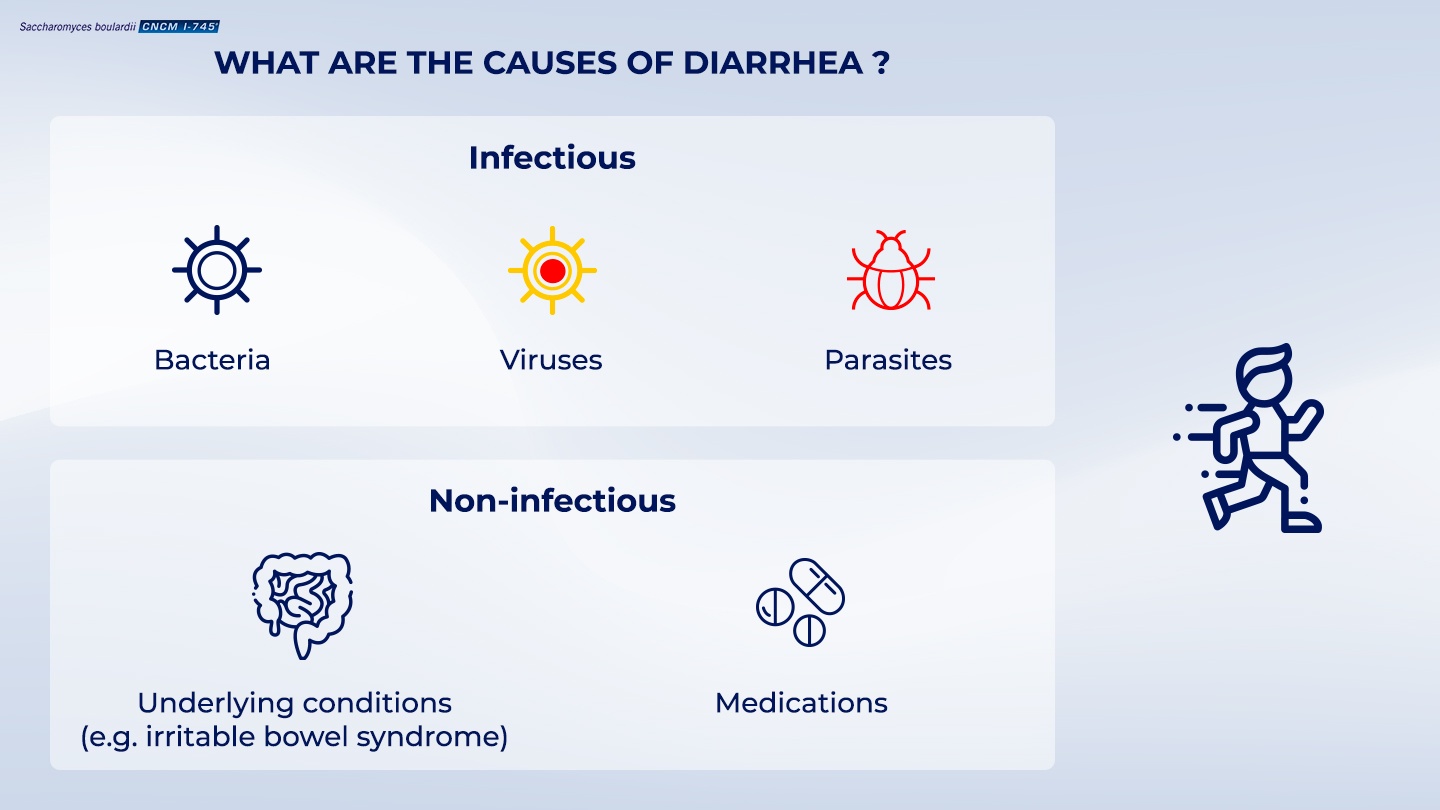Saccharomyces boulardii CNCM I-745: it prevents, treats and helps to recover from diarrhea and its causes
- 4 min
What causes diarrhea?
Diarrhea, loose or watery stools along with increased frequency of bowel movements, is a common problem in both developing and industrialized countries.1 Diarrhea occurs when too much fluid is drawn into the bowel and cannot be reabsorbed by the intestine.2
Most commonly, diarrhea is caused by infections due to viruses, bacteria or parasites.1
The main cause of acute diarrhea in both industrialized and developing countries are viruses, which cause one third of diarrhea hospitalizations.3 These generally peak during wintertime.3
In developing countries, bacterial infections that occur peak during warmer weather/summertime are the most common causes of diarrhea.3 They spread via contaminated food or drinking water.3
Diarrhea can also have non-infectious causes such as underlying medical conditions or drugs such as antibiotics.2
Causes
Infectious3
- Bacteria (e.g. Clostridium difficile, Escherichia coli, Shigella, Vibrio cholerae, Salmonella)
- Virus (e.g. Rotavirus, Norovirus)
- Parasites (e.g. Cryptosporidium parvum, Giardia intestinalis)
Non-infectious2
- Underlying condition (e.g. irritable bowel syndrome)
- Medications (e.g. antibiotics)
In fact, antibiotics can cause both infectious and non-infectious diarrhea.4 First, it can cause diarrhea due to disruption of the composition and diversity of gut microbiota.4 Secondly, because of the change in microbiota, there can be an overgrowth of infectious opportunistic bacteria such as C. difficile.4 This can lead to recurrent infections and bouts of diarrhea.4

(Internal code : 20.60)
How long does diarrhea usually last for?
Diarrhea can be self-limiting and resolve in less than 14 days.2 However, in some instances, diarrhea can last over 14 days leading to dehydration and persistent malnutrition.2
Duration
- Acute diarrhea (<14 days)3
- Persistent diarrhea (>14 days)3
- Chronic diarrhea (>1 month)2
Did you know?
Saccharomyces boulardii CNCM I-745 can be a solution to prevent, treat and recover from diarrhea.
The causes and symptoms of diarrhea can be addressed by the single-strain yeast probiotic Saccharomyces boulardii CNCM I-745.5 This specific strain can prevent, treat and help recover from diarrhea.5
It was discovered when a French microbiologist visiting South East Asia in 19235 noticed that people who drank a concoction made of the skins of litchis and mangosteens, did not get diarrhea during an outbreak.6 The yeast S. boulardii CNCM I-745 was identified as the reason these people did not develop diarrhea.6 The yeast has since been demonstrated to have multiple ways in which it can act on diarrhea, including : 5
- Stimulate the immune system to destroy harmful bacteria
- Prevent inflammation which can damage the gut
- Stop harmful bacteria and their toxins
- Promote normal gut cell function
- Restore the normal gut microbiota population
These effects of S. boulardii CNCM I-745 can reduce how often and long diarrhea occurs as well as prevent recurrent infections.5
Since it was discovered S. boulardii CNCM I-745 has been investigated in more than 100 clinical studies, leading to its recommended use by several international guidelines for several types of diarrhea, including World Gastroenterology Organization7 and the European Society for Pediatric Gastroenterology, Hepatology, and Nutrition guidelines for:7,8*
- Prevention and recovery from antibiotic-associated diarrhea
- Prevention of recurrent diarrhea due to Clostridium difficile
- Treatment of acute diarrhea in adults and children
*The prescribed usage of Saccharomyces boulardii CNCM I-745 for different conditions varies country to country. Please refer to your local Product Information, or speak with your doctor.
Internal code : 20.09
References
- 01 . World Health Organisation Fact Sheet: Diarrheal Disease. https://www.who.int/news-room/fact-sheets/detail/diarrhoeal-disease. Last accessed 16th December 2019.
- 02 . Guandalini S, and Vaziri H, eds. Diarrhea: diagnostic and therapeutic advances. Springer Science & Business Media, 2010.
- 03 . Farthing M, et al. Acute diarrhea in adults and children: a global perspective. Journal of clinical gastroenterology. 2013; 47(1): 12-20.
- 04 . McFarland LV. Antibiotic-associated diarrhea: epidemiology, trends and treatment. Future Microbiology. 2008; 3(5): 563-578.
- 05 . More MI, and Swidsinski, A. Saccharomyces boulardii CNCM I-745 supports regeneration of the intestinal microbiota after diarrheic dysbiosis–a review. Clinical and experimental gastroenterology. 2015; 8: 237.
- 06 . Joly, F et al. 2017. Saccharomyces boulardii CNCM I-745. Marteau, P and Dore J (Ed.), Gut Microbiota: A full-fledged organ. 2017: 305-326. Paris: John Libbey Eurotext. Gut Microbiota Book.
- 07 . Guarner et al. Probiotics and prebiotics. World Gastroenterology Organisation Global Guidelines. February 2017. https://www.worldgastroenterology.org/guidelines/global-guidelines/probiotics-and-prebiotics/probiotics-and-prebiotics-english. Last accessed 16th December 2019.
- 08 . Szajewska H, et al. Probiotics for the prevention of antibiotic-associated diarrhea in children. Journal of Pediatric Gastroenterology and Nutrition. 2016; 62(3): 495-506.
